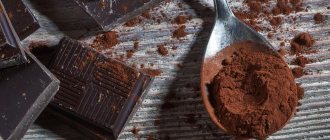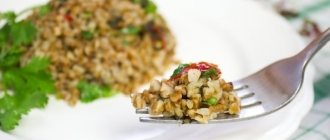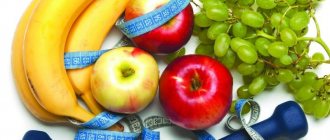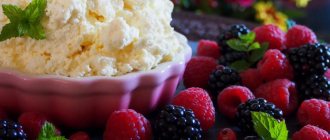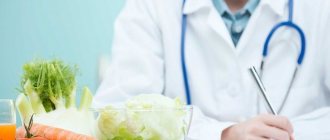The suggestion that a gluten-free, casein-free diet (GFCF diet) may influence mental health, particularly in cases of psychiatric and behavioral symptoms, opens up various possibilities for potential improvements in quality of life.
Autistic children have problems with metabolic processes, nutritional deficiencies (lack of vitamin B6, B12, B1, Ca, Zn, etc.) and digestion (diarrhea, constipation, colic, frequent regurgitation, dysbacteriosis). This is due to the fact that the enzymatic activity of the intestines is reduced, and the enzymes are not able to completely process casein and gluten proteins into amino acids.
Article on the topic: Vitamins for autism - what to take
As a result, molecules of casomorphins and gluteomorphins are created - opioid peptides that cause headaches, brain fog, low concentration and sudden mood swings.
There is also an opinion that due to the increased content of bacteria, the intestinal walls of autistic people become thinner - “leaky gut” syndrome, this leads to the fact that unprocessed protein, as well as bacteria, can penetrate into the blood and brain, thereby causing harm to the body .
Article on the topic: Biomed treatment of autism
Glue for the body
In its pure form, the source of gluten is obtained from wheat dough, washed until the starch “wastes”. Fibers that do not dissolve during washing are processed. It's called seitan. A well-known meat substitute for vegans and vegetarians. Homeland: China. Geography: Asian countries.
What is wheat gluten famous for?
Has no cholesterol. High content of microelements. There is soy gluten - tofu.
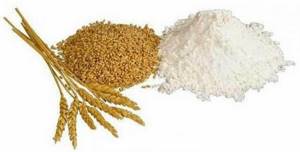
Used with restrictions in various types of gluten-free diets. Tofu does not have the full spectrum of amino acids that wheat is so rich in.
In its pure form, gluten is a tasteless gray mass.
How many amino acids are in gluten
More than 18. Of these, lysine and methionine are part of the triad that determines the value of products. To absorb tryptophan, you need carbohydrates - cereals, bread, pasta, etc.
Bread products provide protein to the diet by 25-30%. That most delicious crispy crust in the world is a gift; there is more benefit in it than in the entire loaf. Antioxidants are stored in a “crust from childhood.”
When talking about the dangers of gluten, they emphasize the “accumulation” in excess, which “glues” and limits the ability of the small intestine to absorb vitamins and other necessary substances. Symptoms of “excess” gluten: weakness, lethargy, sleep problems, acne, inflammatory processes. Similar to signs of other metabolic problems, gastrointestinal disorders.
According to this logic, a gluten-free life will cleanse you of toxins and provide vitamin and mineral intake. But the fact that complex plant protein is harmful to a healthy person is controversial.
Plant-based and vegan cheese: composition
cheese product , is also popular today . This cheese product is made from plant materials.
Vegetable cheese can be divided into 2 types. A cheese product that contains animal oil is vegetarian cheese . And a cheese product that does not contain any animal products - vegan cheese .
Both dairy and non-dairy cheeses contain a base, fats, seasonings and additives.
The basis for dairy-free cheese is plant-based soy milk. In general, plant milk can also be made from plants such as: coconut, soy, almonds, hazelnuts, oats, rice. But for cheese, as a rule, a soy base is used.
Fats (or oils) for dairy-free cheese are usually used:
- For vegetarian cheeses – cream or vegetable.
- For vegan cheeses – only plant-based (most often coconut).
The Ubiquitous Gluten
It turned out to be gluten. In the food industry, the properties of gluten are exploited - the ability to increase volume and shelf life.

The consumer receives gluten in greater quantities than he or she may realize, in both overt and subtle forms. We have long mastered the art of reading labels, where important information is written in small print about what we are going to include in the biochemical cycle of the body.
The fact that gluten is “unofficially” present in products containing modified starch and additives has been confirmed. The motivation for using a gluten-free diet for body shaping by healthy people is based on this fact.
Textured vegetable protein, modified starch, hydrolyzed vegetable protein - this means the product contains gluten!
- Porridges made from oats, barley, wheat, rye
- Bread made from traditional flour
- Sausages, sausages, minced meat
- All sauces
- Sweets
- Ice cream, shelf-stable yoghurts, sweet curds, cheesecakes
- Canned fish, meat
- Alcoholic drinks made from cereals
- Instant coffee, flavored tea, tea bags
- Convenience foods, carbonated sweet drinks, etc.
The fact is that with the exception of cereals, these products are not welcomed by other methods. They are not included in the list of recommended “healthy food plates”. Thus, the vast majority of foods prohibited during a gluten-free diet are also excluded during a healthy lifestyle.
Smart reboot
It is recommended to safely adhere to such a diet for a short period of time. It is safe to eliminate gluten for a week if your state of mind and body allows.
The usual foods will remain in the diet:
- Meat and fish, poultry
- Vegetables
- Fruits, berries
- Homemade sauces without wheat flour
- Dairy products
- Milk in dishes
- Cheese
- Eggs
- Buckwheat, rice, millet, corn
- Vegetable and butter
- Honey
- Bread, pastries, pasta made from gluten-free flours
Healthy cooking methods are practiced: boiling, stewing, grilling, baking, steaming
Casein
Casein is a milk protein of animal origin. It is found in all dairy products, including yogurt, cottage cheese, kefir, and all types of cheese (by the way, it contains especially a lot of casein).
Children with autistic disorders often have an intolerance to this protein. During the breakdown process, the substance forms casomorphine, a type of opiate, which leads to negative changes in mood, depression of consciousness, apathy, or vice versa - excessive excitement.
Products contraindicated in case of casein intolerance: goat and cow's milk, fermented milk products, butter, cheese, cottage cheese, as well as any dishes that contain the listed products.
Fifty fifty
For every pro argument, there can be as many cons.
For example, five yes:
- You carefully monitor your diet.
- Consume more natural products.
- Read the labels. The composition of the products is under control.
- You can eat well.
- Fast food, baked goods, buns, and industrially produced cakes are automatically excluded. Which contributes to a healthy diet.
Five no
- It’s easy to go too far and overdo the restrictions. In this case, you interfere with organic processes without fully understanding their significance. Biochemistry is not a science for amateurs. A profound restructuring of the body is taking place. Requires supervision by a nutrition specialist. Conflicting information about gluten in context for a healthy person.
- The content of foods with starch in the diet increases.
- You are depriving yourself of the “gluten” benefits. Vitamins, minerals, amino acids. Diet cannot be 100% classified as a healthy lifestyle. Approach your choice consciously, look for sources from the world of products. Supplement your diet wisely.
- Make your own medical diagnosis. There are cases when they decide that gluten is “to blame” for the problems, which is not a confirmed fact. Because A whole group of diseases and types of ailments have similar symptoms.
- Labor intensive, not for the lazy. If used for figure correction, it requires home preparation. For example, “healthy pasta” made from buckwheat flour. Guaranteed natural products, without industrial excesses, are suitable for weight loss. It is also important to learn how to bake baked goods by purchasing a bread machine. This is necessary to achieve results and provide a complete menu.
“Soft” forms, intended for people without pathologies, suggest eliminating “excess” gluten, normalizing the total content, and tracking the “sources” of gluten.
A variety of recipes, including baking from buckwheat, rice, soy flour. Meat, fish, careful processing before use for food. Cereals in the form of buckwheat, brown rice, and the use of healthy, unrefined vegetable oil make the menu, with some effort, home-cooked, acceptable for a balanced diet.
There are 2 main groups that have tried gluten-free diets:
- For medical reasons. This is a necessity. Reviews give practical advice, share information and recipes. They note the positive dynamics and talk about potential obstacles for those starting the gluten-free journey.
- At your own request, for weight loss. Results vary depending on the timing of compliance and individual characteristics. Reviews range from critical, skeptical to positive. Nevertheless, it is worth noting the popularity; they note, among other things, a general improvement in well-being and emotional mood.
Gluten-free-casein-free diet for autistic children
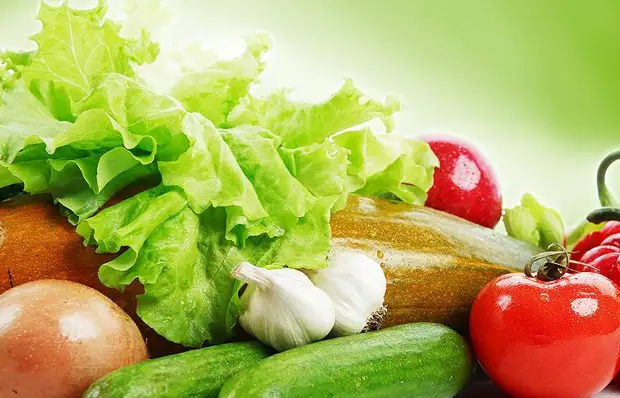
When discussing autism seriously, the term “gluten-free-casein-free diet” is often mentioned among possible correction options. From the name it is clear that the diet excludes foods containing gluten and casein. Let's figure out what it is. Not a panacea, but a help Diet is not a panacea, but just one of the steps on a child’s path to our world. Scientists have allegedly identified more than thirty causes of autism, many of them in one way or another related to possible gluten intolerance. This is why experts talk about the importance of diet. The effectiveness of this remedy can only be understood and assessed experimentally. In any case, with a wise approach it will not get worse, and the likelihood of improvement is high. After all, well-known happy stories of victories over autism included a gluten-free, casein-free diet. The question arises, what kind of diet is this and how to follow it correctly. First, it is important to understand which substances should be avoided (or rather, eliminated completely) when creating a menu. Firstly, it is gluten, a concept that unites a group of proteins contained in the seeds of cereal plants, especially wheat, rye, oats and barley. The gluten content in wheat reaches 80%. Secondly, casein, the main protein in milk, should be excluded (there is half as much of it in human milk as in cow's milk).
With gluten intolerance, larger molecules can be absorbed from the intestinal lumen into the blood, while in healthy people almost all substances are hydrolyzed to monomers.
In addition, if a certain enzyme is deficient, the proteins gluten and casein are not broken down into amino acids, resulting in the formation of molecules of casomorphins and gliadomorphins. According to one theory, in autistic people, as a result of thinning of the intestinal walls, these molecules penetrate into the blood, are transported to the brain, where they accumulate, causing effects similar to those of opiates, plunging the person further and further into himself, isolating him from the outside world. Theoretically, there are tests that can show the need for a diet (for example, urine for urinolysis and blood for antibodies to gliadin), but the test result is positive only in extreme cases (for example, with celiac disease). If the situation is not catastrophic, then the tests will be normal, without answering the question of whether a diet is needed. Most experts agree that every child with autism should follow this diet at least occasionally, even if there is no obvious improvement from its use. Naturally, if there are improvements, then you need to stick to the diet for as long as possible. The earlier the child starts eating this diet, the more obvious the results. Prohibited and allowed foods So, what is not allowed on the GBQ diet?
“Prohibited” products can be divided into two categories: obvious and non-obvious. Obvious ones:
- Wheat, rye, barley, oats, milk and any products made from them.
- Flour from wheat, rye, oats.
- All bakery products - buns, bread, pies, crackers, etc., as they contain rye, wheat, and oat flour.
- Pasta.
- Porridges from the above mentioned cereals: semolina, oatmeal “Hercules”, “Artek”, from the “5 (7, 10, etc.) cereals” series, pearl barley, wheat, barley.
- Various semi-finished products: dumplings, ravioli, pasties, cutlets, nuggets, etc.
- Breaded products.
- Dairy products: milk, kefir, fermented baked milk, yogurts, cottage cheese, hard cheeses, condensed milk.
- Confectionery: cakes, pastries.
Unobvious - those where the recipe contains gluten-containing cereals or milk powder, which may not be indicated on the packaging.
- Sausages and sausages, cutlets.
- Canned meat and fish.
- Sauces, mayonnaise, ketchup.
- Dry semi-finished soups, bouillon cubes.
- Cocoa powder, instant coffee, kvass, instant children's drinks (such as Nesquik).
- Candies, chocolate, ice cream.
Please note that coated tablets are not recommended as they contain gluten. And liquid dosage forms often contain malt (for example, Novo-Passit). After reading the first list, it begins to seem that nothing is impossible, but this is not so. Over time, the arsenal of recipes will become equal to a good cookbook. Allowed:
- Soups, borscht without dressing with store-bought sauces, without prohibited cereals.
- Meat, poultry, fish - in unlimited quantities, especially since before the diet the child, most likely, practically did not eat them.
- Eggs.
- Porridge made from buckwheat, rice, corn grits.
- Rice flour, corn flour, buckwheat flour. There is an important caveat here: since they are, as a rule, produced at the same enterprise with wheat flour, no one guarantees the purity of the flour from prohibited impurities. The best option is to make do with a home coffee grinder: not so fine, but reliable, and quite suitable for basic shortcakes.
- Vegetables, fruits, dried fruits, nuts.
- Natural juices (preferably homemade).
- Vegetable oil.
- Honey.
- Instead of breadcrumbs, we use starch.
It’s not easy to adjust to a new regime: you’ll have to give up your usual foods, semi-finished products, sauces, sausages... Kitchen appliances will make life much easier. And over time, a habit will come.
About the timing The minimum period of giving up gluten required to remove previously accumulated gluten from the body is about four months. Changes in behavior for the better often begin much earlier, strengthening the mother's confidence in the correctness of her actions. Even if there are none, experts still recommend sticking with it for four months. The test diet for sensitivity to casein can be shorter - only three weeks, but it is recommended to wait a full four months, and then gradually begin to introduce fermented milk products, carefully monitoring both the gastrointestinal tract reaction, the presence of redness, rashes, and behavioral aspects (sleep, nervousness, lethargy or, conversely, hyperactivity). Difficulties can be overcome Oddly enough, the most difficult stage on the path to following the GBQ diet is its implementation. It is unrealistic to explain to a child that he cannot eat the goodies that the rest of the family members are cheerfully eating. And if you simply ban it, the psychological pressure on the child increases significantly, which is unlikely to help on the way out of autism. Therefore, it is logical to put the whole family on a diet (attending kindergarten during this period is out of the question). Here are the main difficulties: dad cannot eat herring without bread, grandmother cannot imagine life without Sunday baking, and the brothers and sisters will never part with their nightly yogurt. The option where everyone quietly eats what they want is not suitable: if there is a forbidden product in the house, it means that the little one will find it, and weeks or even months of diet will go down the drain. After all, the question is not about limiting gluten, but about its complete exclusion. Any violation throws the child’s condition back. The ingenuity and miracles of balancing act that kids show in search of bread and cookies are simply fantastic, so declassifying the storage locations of prohibited products is a matter of time. Is it worth it? Understanding that diet is the path to recovery for your beloved son, grandson, brother can help in negotiations with family. In addition, there are also unexpected advantages of the diet itself for other family members: normalization of weight, improvement of the gastrointestinal tract, avoidance of processed foods, that is, healthier eating... Serious difficulties are also created by the fact that many outlets have strange culinary preferences: often limited to two - three products, they flatly refuse everything else. Some people drink liters of milk, others prefer bread and butter. As a rule, these children do not like and do not eat meat and vegetables, thereby disrupting the functioning of the gastrointestinal tract and brain. But since they can starve for days, demanding their favorite dish, mothers involuntarily obey, limiting the menu to the baby’s tastes. It is interesting that the menu often narrows along with the child’s “withdrawal” into himself: often, when analyzing, mothers remember that six months ago it was possible to feed their child soup or stewed cabbage, but then they managed to do this less and less often, until complete refusal. So, the firm decision to go on a diet with the whole family was made and approved at the family council. What to do next? Action plan It will be difficult to switch to a diet, excluding your most favorite foods. It is important to carefully study what the child eats - at least sometimes, at least one dish that will become a bridge to normal nutrition: buckwheat, rice, corn porridge, millet, eggs, meat, soups, potatoes, fruits, juices, etc. After all, At first the child will only eat it. And the more such dishes there are, the easier the transition will be. We are making a list of acceptable dishes that you will prepare for the whole family - sooner or later the little one will come to you, especially if it is not pedagogical to allow him to eat from your plate. We determine who, when and how will care for the child due to the impossibility of attending kindergarten or primary school. We finish all prohibited foods by the planned hour X. We warn all friends and acquaintances who periodically come to visit you that it will be better if instead of cakes and chocolates they bring fruit with them, instead of sausage - a piece of raw meat, etc. We fill the refrigerator and kitchen shelves with approved products, study new recipes and analyze old ones for their modification (for example, what prevents you from replacing bread in cutlets with boiled rice or starch?). We scour the Internet and recipe books in search of new ideas. We prepare mentally: it is important to stock up on incredible patience and firmness, to understand what is happening to the child - several days of hysterics, aggressiveness, hunger strike, even behavior similar to drug withdrawal are guaranteed. Actually, in essence, this is withdrawal – the body requires more and more portions of gluten. You just have to get over it. The transition to a diet in behavioral terms is greatly simplified by giving up sugar in advance (at least a week in advance), which has a stimulating effect on the nervous system. Of the sweeteners in teas, compotes, and uzvars, we leave only honey, of course, if there is no allergy and in small quantities; for desserts, only fruit. During the diet, we also adhere to the maximum limit of sweets. It’s easy to evaluate the benefits of a “sugar-free” diet: don’t give your child sweets for at least a week, and then give him a candy (chocolate), enjoy the hysteria that immediately follows for some reason, and draw conclusions. We prepare several dishes at once so that the baby can choose his favorite one from those allowed. Don’t be upset if your child eats only buckwheat or borscht for a whole month - the expansion of the diet will still begin slowly. We consult with a doctor about vitamins - after all, without receiving fermented milk, the child needs additional calcium, and without yeast dough, he needs B vitamins. It is advisable to select multivitamins (without coating!) in advance, so as not to encounter allergy problems at the most inopportune moment. We carefully monitor the reaction to fruits, dried fruits, nuts: many parents complain that a certain fruit provokes a hysterical state. Oddly enough, the leaders here are apples, bananas, and raisins. We remove provocateurs from shopping lists, replacing them with something harmless. Possible negative consequences A sudden switch to a diet for a child who does not eat foods allowed by the diet at all can be fraught with anorexia. Therefore, in this case it is necessary to approach the problem especially carefully. Perhaps, through trial and error, you will still be able to select at least one dish allowed by the diet, which the child will sometimes agree to eat even before the introduction of the diet. Having at least one approved product in your portfolio, you can safely start.
Most online resources dedicated to autism have entire sections where parents discuss the benefits of diet (or, conversely, the lack thereof). Before making a decision, read the reviews: this will either confirm you in the necessity or in the pointlessness of the idea. The vast majority of parents who correctly organized the transition to a diet for the whole family, strictly and strictly followed all the requirements, note improvements in the behavior of their children long before the minimum four months of the diet expired. The author of these lines saw the first results literally in a week. So, good morning! And let’s hope that the BGBK diet can help at least a little on such a difficult and short journey for a baby into our world.
Source
An apple from an apple tree...
You should not mix gluten-free diets with a group that triggers the process of ketosis – the body’s reserve “nutrition” that burns accumulated fat under certain conditions. They are similar in the list of permitted products, in terms of severity. But: they use a different mechanism, preventing the consumption of carbohydrates, so that the body uses a reserve reserve, “deciding” that it is in an extremely hungry situation. Such diets have contraindications!
The group includes:
- Diets with the KETO prefix, which you can easily get acquainted with in the gym.
- Dukan diet, Kremlin diet - high protein and low carbohydrates.
- Low-carbohydrate diets – those that exclude sugar and foods containing it.
BGBK diet - list of products
If you decide to start your child on a gluten-free/casein-free diet, it is very important to pay attention to some nutrients such as vitamin D, calcium, iron, protein and fiber that may be missing from this meal plan. In the table below we provide a list of foods that can help you get enough of these important nutrients:
| Nutrients | Required Products |
| Vitamin D | Rice, soy and almond milk; fish fat; tofu, eggs; short-term exposure to sunlight; biologically active additives. |
| Calcium | Rice, soy and almond milk; fortified orange juice; beans, broccoli, spinach, cabbage, tofu, tempeh; biologically active additives. |
| Iron | Red meat, pork, chicken (mostly dark meat), crustaceans, egg yolk, spinach, soy nuts, prunes, raisins; biologically active additives. |
| Protein | Eggs, nuts and seeds, lean meats, beans, peanut butter. |
| Cellulose | Legumes, fruits, vegetables, nuts, seeds; biologically active additives. |
Medicinal “gluten-free”
If you experience discomfort, periodically arising and disappearing pain without an obvious cause, allergic reactions associated with food, it is better to dispel suspicions and doubts by contacting an allergist, immunologist, gastroenterologist, or nutritionist. This is especially true in the case of children.
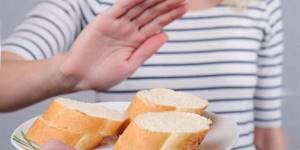
You will receive reliable information and undergo the necessary tests. Make sure that there is no intolerance to another protein - casein, essentially an analogue of gluten of animal origin, exclude a reaction to lactose and lactase deficiency, which are also difficult to reliably determine at home.
In this case, a diet will be recommended that limits the consumption of hidden and obvious sources of “milk sugar”, i.e. lactose, milk-containing products and milk, if necessary - fermented milk products containing casein, lactose - the latter, in smaller quantities, in a “destroyed form”.
This way you will maintain your health and that of your child.
Types of therapeutic diets that exclude gluten:
- Gluten-free diet for a certain period of time. Recommended by a gastroenterologist for appropriate symptoms.
- Long-term gluten-free diet. Necessary for a diagnosis of Celiac Disease, which means gluten intolerance, rejection as a foreign substance from the body. Celiac disease is rare. Explained by genetic characteristics.
- The BGBK diet for children with autism involves eliminating not only gluten, but also casein, a similar protein found in dairy products. The word “gluten” literally means “glue,” and casein means “cheese.” An alternative method, research has been carried out. In some cases, there is an improvement in the well-being of a special child.
A short reminder
- Only a doctor can determine whether there are medical indications for such nutritional methods.
- Remember that symptoms such as general fatigue, decreased energy levels, stomach pain, and intestinal disorders can occur with a variety of diseases.
- It is necessary to take a blood test and test for intolerance; a specialist will determine the type of diet and its need.
- Therapeutic diets for children require the most detailed consideration.
- Make a decision only after a medical examination!
How to replace casein and gluten
Options for replacing familiar foods such as bread, cookies, butter, milk and kefir for an autism diet:
| Gluten | ||
| Bread, cookies, pies, buns | Bread made from rice, corn, coconut flour. | For greater viscosity, guar gum or flax seed flour can be added to BG flour. |
| Crispbreads and cookies marked “gluten free”. | ||
| Rye bread | Bread made from rice, corn, buckwheat flour with the addition of nut, amaranth or flaxseed. | |
| Oat groats | Sold as gluten free. | |
| Sweets | Marmalade | Even products that do not contain flour are best purchased with the “gluten-free” label. |
| Lollipops | ||
| Marshmallow | ||
| Halva | ||
| Corn sticks and flakes | ||
| Casein | ||
| Milk, kefir, yogurt | Rice, coconut, nut (any nuts), buckwheat, soy milk | You can prepare all types of milk and butter yourself or buy them in a hypermarket or online store. |
| Butter | Ghee, coconut oil, soybean, vegetable, olive, baby margarine | |
| Cheese | Soy and pea products are sold and prepared at home. | |
| Cottage cheese | — | Not substituted to suit taste, but calcium can be obtained from leafy greens, apricots, dried fruits, nut milk and soy milk. |
Not by bread alone
Yes, you won't have to eat bread. In particular, wheat and rye. There are alternatives in the form of buckwheat flour, special baked goods, and homemade recipes.

Of course, people consume many types of foods, the most exotic ones. Proof of this are the recipes of the diverse cuisine of the peoples of the world.
In Southeast Asia, they traditionally eat insects; in the harsh climate of the North, they eat raw meat; they obtain vitamins and microelements from the blood of deer. In Norway you can try a specific fish that is “spoiled” using technology. On Lake Baikal you will be treated to omul “with flavor”. At the same time, such nutrition is justified by natural conditions and is familiar to residents.
Our body, like a musical instrument, can be tuned to any tone. It is important to be able to listen to yourself, understand the signals that he gives, and respond to them competently. A healthy balance is important; specialists who know the properties of products and their compatibility help to maintain it. Harmony is the key to health. Treat food with care, read books on nutrition, get competent, professional advice. Then dietary food will bring many times more benefits and tasty variety to your table.
Lose 20 kg in one week at home - myth or reality
Top 7 best drugs for weight loss
| Name | Price |
| Black Latte for weight loss | 99 rub. |
| NATURAL Fit Calorie Blocker Powder | 990 rub. |
| Purple tea "Chang-Shu" | 499 rub. |
| Fat burning drops “Honey Spas” | 1980 rub. 99 rub. (until 02/12/2021) |
| Detox cocktail for weight loss | 147 rub. |
| Lipocarnit for weight loss | 990 rub. |
| Reduslim weight loss product | 149 rub. |
Views: 6,626
Gluten-free diet (GF) for autism
Gluten (gluten) is an insoluble protein substance consisting of 2 proteins gliadin and glutanin. It is found in some cereals - wheat, rye, barley and oats. The Latin name gluten means glue, which is why it is sometimes called gluten. Wheat contains the most gluten - up to 80%.
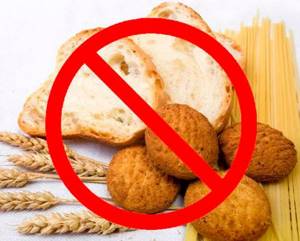
Very often, autistic children develop intolerance to gluten, and when it enters the autistic child’s body, he develops an immunological reaction - the villi in the small intestine, which help absorb vitamins and microelements, are destroyed.
The stickiness of gluten interferes with the absorption of nutrients, the villi are smoothed out and poorly digested food turns into a pasty substance that irritates the mucous membrane of the small intestine. Children with gluten intolerance often experience diarrhea or constipation, weight loss, low hemoglobin, abdominal pain, and the child’s immune and nervous system suffers.
It is also important to remember that if you do not receive cereal products for more than 3 months, the body will experience a deficiency in dietary fiber and B vitamins, which can negatively affect the child’s health, because B vitamins are necessary for the good functioning of the nervous system and digestive tract. Therefore, when following a HD diet, it is important to replenish the body’s reserves of vitamins and minerals.
Bread and its derivative products are replaced with baked goods made from corn, rice and buckwheat flour.





